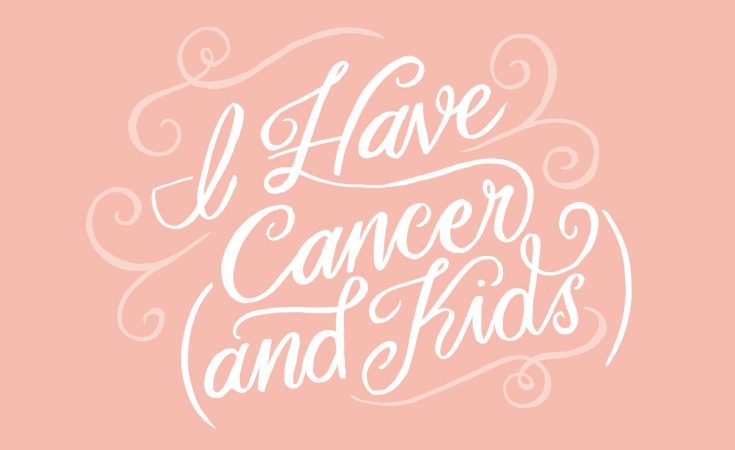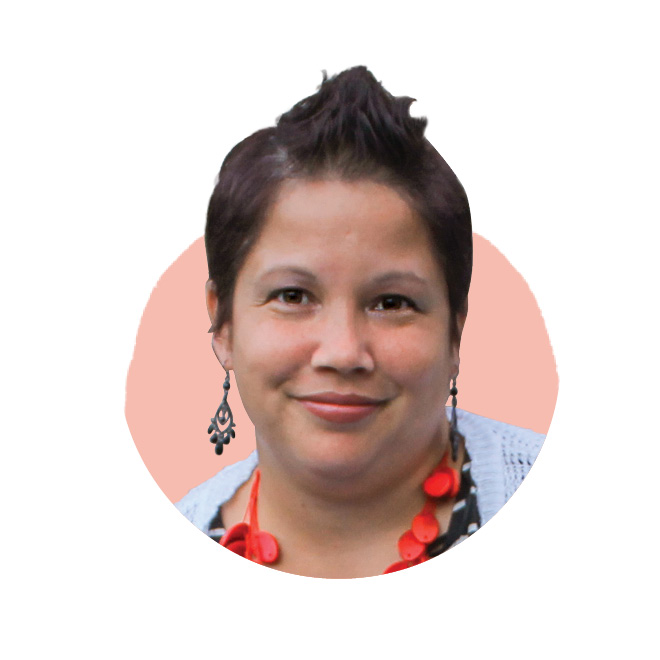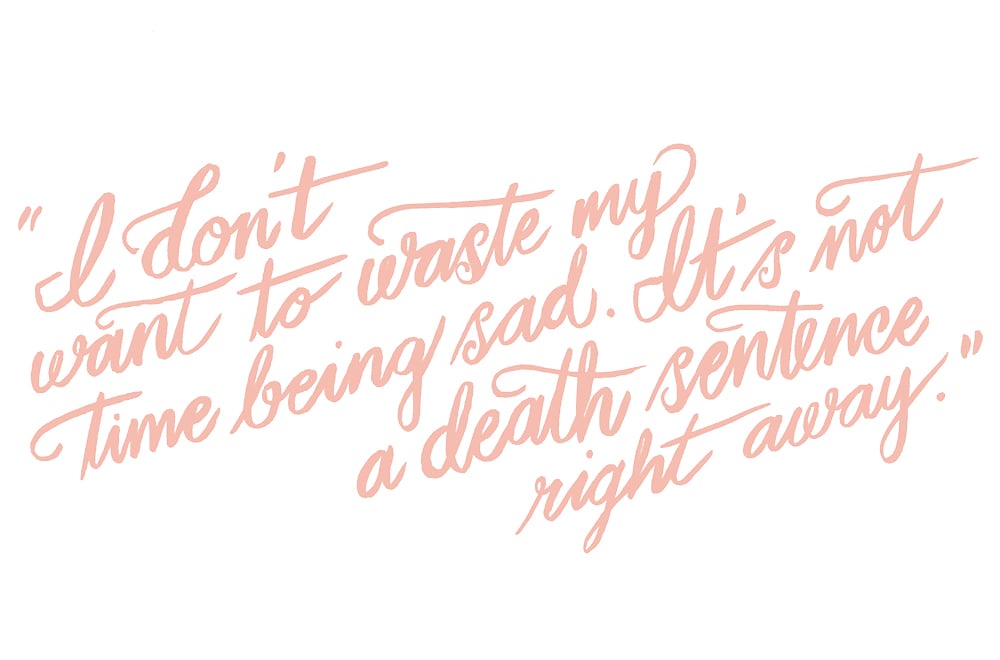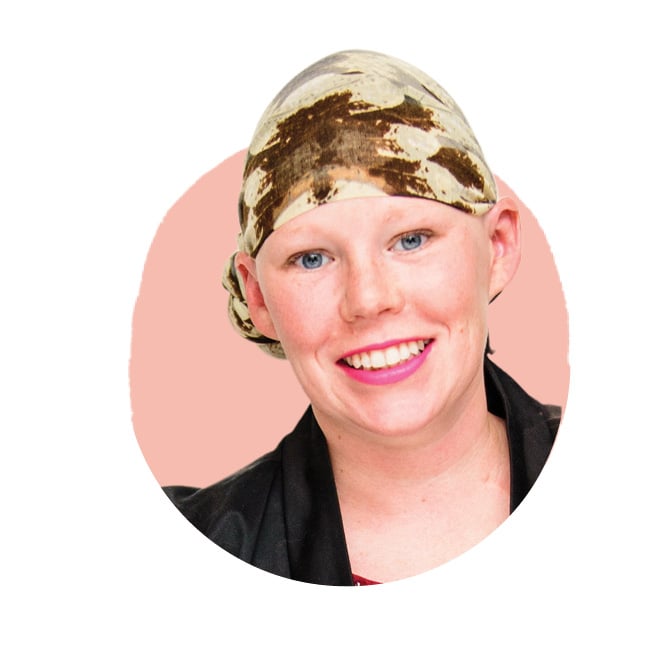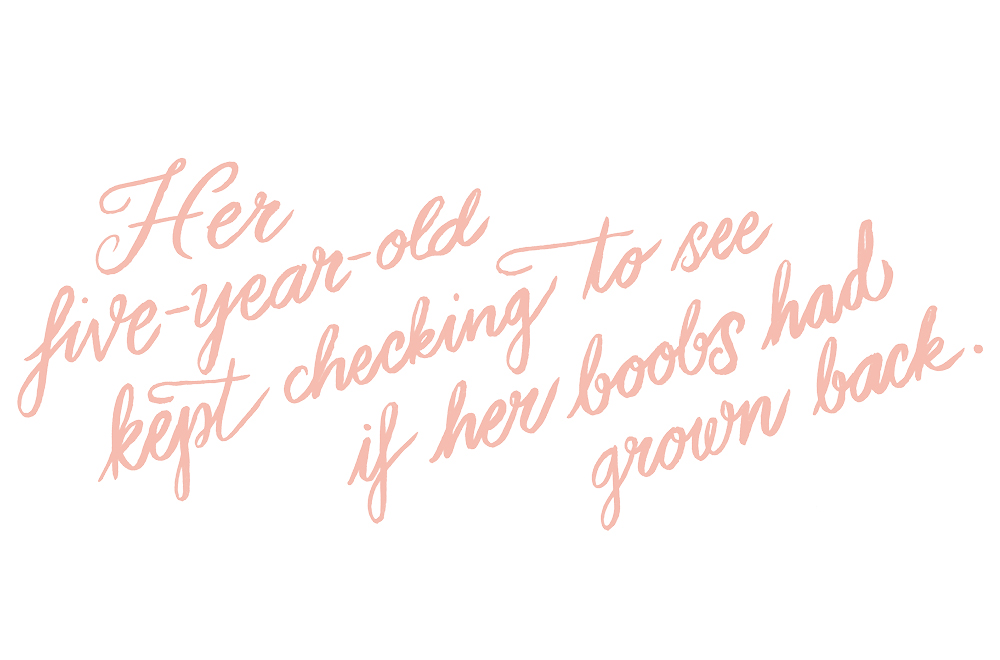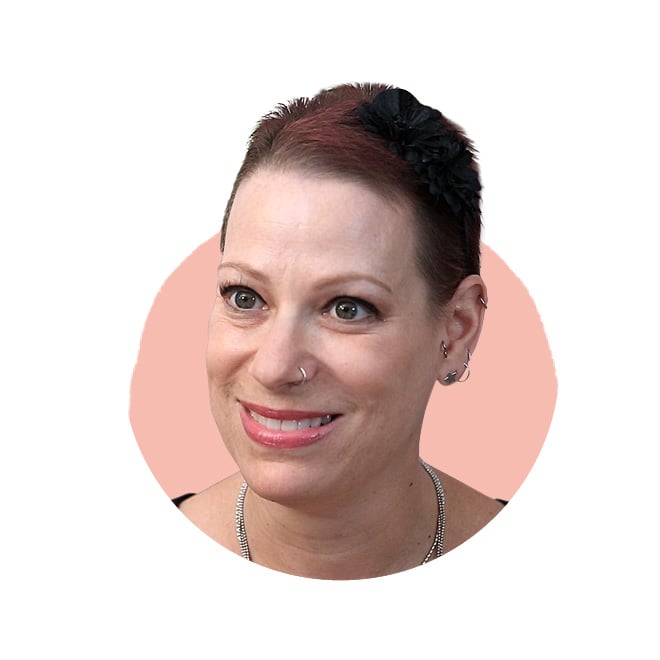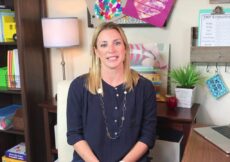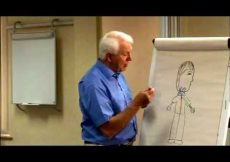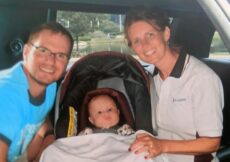Of all the monsters parents clear from beneath beds and darkened closets, few actually have us in their crosshairs. There’s one scary beast, though, that takes hold of unlucky moms and bites into entire families. Breast cancer, although primarily diagnosed later in life, affects about 1,200 Canadian women under the age of 40 each year. For them, diagnosis arrives when life seems so full it’s overflowing: with growing families, work, overlooked dust bunnies, friends that don’t deserve another last-minute cancellation. Yet the onset of breast cancer demands all of it be put on the back burner so Mom can deal with an enormous challenge—often one she’s never felt less equipped or more surprised to face.
“No one has more claims on their time than parents of little kids. And no one expects, as young adults, to get cancer,” says Geoff Eaton, executive director of Young Adult Cancer Canada. “The reality of having to face the possibility of your death way sooner than you were expecting is a lot more intense when you have children.”
Many women’s first thought upon being diagnosed is whether they’ll die from it. That fear is fed by the statistics showing that women under 40 tend to have more aggressive forms of breast cancer and face higher likelihoods it will recur later in life.
But these days, a breast cancer diagnosis doesn’t necessarily amount to a death sentence. Although 15 percent of women under 40 with breast cancer will succumb within five years, 85 percent will survive. Still, most patients can’t help but see their lives—and those of their kids—flash before their eyes. When you have children clamouring for your attention and time, children you want to protect from grief, and children to whom you want to give as normal a life as possible, sometimes there isn’t much else for moms with breast cancer to do than carry on. To understand how they cope, Today’s Parent sat down with three moms at various stages of their struggles with the disease.
Laura Rice, 34
When Laura Rice and her husband, Greg, told their families that a baby was on the way, their announcement involved two positive tests. Along with the happy news, they also divulged that Laura had the genetic mutation which put her at high risk for developing breast cancer.
The Collingwood, Ont., couple had learned they were about to become first-time parents the same week doctors confirmed Laura had a mutation of her BRCA1 gene. While that didn’t mean Laura had cancer, it boosted her odds of getting the disease up to 85 percent and confirmed her long-held suspicion that, like most women in her family, she was likely to spar with the big C.
“My mother is a two-time survivor. One of my sisters is a survivor; one is metastatic. My grandmother had it three times. My aunt died from ovarian cancer. We knew cancer might be in our future,” she says.
Normally, BRCA1—a gene we all have, pronounced “bracca-one”—helps repair damaged DNA that can lead to cancerous cell growth. When there’s a mutation, it can’t do its job, and DNA damage that can lead to tumour growth builds up. Women who have the mutation are more likely to develop breast or ovarian cancer, and many consider preventive mastectomies or, in the case of ovarian cancer, a salpingo-oophorectomy, the removal of both ovaries and Fallopian tubes. But Laura’s pregnancy meant she had to hold off on any decisions.
Throughout her pregnancy, concerns over what else might be growing in Laura’s 29-year-old body dogged her. “You obviously feel like a ticking time bomb,” she says. For reassurance, she made the trek to Sunnybrook Health Sciences Centre in Toronto for manual exams in their High-Risk Breast Clinic (mammograms are less reliable during pregnancy because of a thickening of the breast tissue; ultrasounds are only ordered if something suspicious is found during a manual exam). When her daughter, Taylor, was born, Laura was lump-free. She breastfed for 13 months and then waited another four before undergoing an MRI and a mammogram (breast tissue is often dense and lumpy during and after breastfeeding).
This postpartum round of tests unearthed a lump. “They said, ‘This is probably it. You probably have cancer,’” Laura recalls. When the results of her lumpectomy came back negative—Laura didn’t have cancer!—she and her husband quickly set about trying for another kid.
“As soon as you get the high-risk diagnosis, you feel like you’re on a condensed schedule,” she says. “We weren’t going to be able to wait three or four years between kids.”
Propelling their rush was the fact that Laura would likely need to consider having a preventive mastectomy, removal of her ovaries or, in a worst-case scenario (if she were diagnosed with cancer), chemotherapy.
The week Taylor turned two, Laura and Greg learned they wouldn’t have just one more baby—they were going to have two. Laura was pregnant with twin girls. She delivered Reagan and Charley via C-section, and also had a salpingectomy to remove both of her Fallopian tubes and reduce her risk of developing ovarian cancer.
For 11 months, she nursed the twins. “Breast-feeding was very important to me,” she says. Four months after they were weaned, Laura went for an MRI and mammogram, which turned up two new lumps. This time Laura, just 33, had stage two breast cancer.
With her doctors suggesting chemotherapy and a double mastectomy—treatments that would require many long trips to Toronto and a SWAT team to help care for her kids—all Laura could think about was Taylor.
“I was stuck on how I was going to tell my four-year-old,” she says. With the help of The Kids’ Guide to Mommy’s Breast Cancer and Mom and the Polka-Dot Boo-Boo, Laura and Greg described the lump to Taylor as a “little black spot” that was making Mommy sick. She would need special medicine that would make her tired. Laura began cutting her hair shorter to help ease Taylor into the phase of chemo where she would be bald. While the preschooler didn’t totally grasp what was happening, she would often demand that Laura, rather than a family member at the house, help out, get her snack, play with her or help her during potty training. While Laura launched into 18 weeks of chemo, a double mastectomy and 25 rounds of radiation, her mother and sisters filled her freezer with food, cleaned her house and looked after the kids.
“I was in a very dense fog,” Laura recalls. “It wasn’t even safe for me to be alone with my children. I couldn’t pick up anything for six weeks, which is a long time when you’ve got kids who are teething and needing you.”
Since completing radiation last December, Laura has had no signs of cancer. Last spring, she returned to work. But post-treatment life has been tough. Being cancer-free doesn’t always mean feeling like your old self again: There can be a grab bag of sometimes lifelong physical symptoms, from fatigue to joint stiffness and bone pain.
“There are more bad days than good,” Laura says. “The exhaustion is ridiculous. It’s like you’re supposed to be that whole marathoning pink ribbon girl. But not everybody can do that.”
The question of whether Laura and her daughters have more cancer in their future lingers, too. “Recurrence is always on my mind,” she admits. “I don’t feel like my fight is over.” Each of her daughters has a 50 percent chance of having the mutation and will have to decide whether to undergo the test once they reach adulthood. Laura is holding out hope, though, that by the time Taylor, Reagan and Charley are 18 and old enough to be screened, they won’t need to be. Maybe by then there will be a cure.
Michelle Riccio, 36
Hand-lettering: Erin McPhee
For most preschoolers, bathtime bubbles are the base for tub-side concoctions of “potion,” “soup” and all manner of sudsy slurries. At Michelle Riccio’s Mississauga, Ont., house, her four-year-old son, Taylor, mixes his soap and bath crayons together to make special “medicine” for his mommy. For as long as he can remember, she’s needed it. Michelle has metastatic breast cancer.
Taylor was just two when Michelle was told that she not only had breast cancer, but it was stage four, a grim diagnosis that meant her cancer couldn’t be removed. Michelle, then 33, would be in treatment for the rest of her life. And there’s no telling how long—or short—that might be.
“I instantly broke down and thought of Taylor,” she says. “When a child is born, you just assume you’re going to be around, to dance with him at his wedding, to help him with his children. It’s not an assumption anymore. Now I’m like, ‘Get me to his first day of school. Get me to his fifth birthday. Get me to Christmas.’”
Metastatic breast cancer means the cancer has spread to other distant parts of the body, usually the liver, bones, brain or lungs. While it can’t be cured, a lineup of tailored, successive treatments (including chemotherapy, radiation and other drugs) are used to beat it back for as long as possible. In Canada, very few women are metastatic when they’re first diagnosed, and even fewer are under the age of 35. Michelle, who has no family history of the disease, was just incredibly unlucky. “I wasn’t a smoker. I wasn’t a big drinker. I ate OK,” she says. “Breast cancer didn’t even cross my mind.”
When she began to have pain in one breast when Taylor wasn’t even a year old, Michelle’s doctors dismissed it as a blocked milk duct. The pain came and went for a couple more years, but an ultrasound showed nothing unusual. But then back trouble began with such severity that Michelle couldn’t even lift up her toddler, the pain in her breast grew worse and she thought it felt harder. Her doctor agreed he could feel something but still thought it could be a blocked duct; he ordered another ultrasound and then a biopsy to be sure.
Nervously waiting for the results, Michelle went on a ski vacation, but she was in too much agony to ski. When she returned, a stunned Michelle learned that not only did she have breast cancer, but that it had already spread to her vertebrae.
“For some reason I didn’t cry,” she says. “I just went into fight mode. I just wanted to get going on treatment and try to keep myself around for as long as possible.”
Two years later, Michelle has had five different treatments and goes for scans every three months to check the cancer’s progression. In the summer of 2015, she learned it had spread to her liver. Since last December, she’s been getting chemotherapy almost every week, which leaves her tired but reasonably functional.
“Right now, I’m able to do pretty much anything I want to,” she says, “but I know this isn’t going to last forever. I try to do as much as possible with my son because I don’t know if tomorrow I’m going to be bedridden.
I definitely have my moments, and I’ll just have a huge, ugly, gross cry. But I don’t want to waste my time being sad. Even with a stage four diagnosis, you can still live your life. It’s not a death sentence right away.”
Now 36, Michelle chronicles her life on her blog, Tit Happens. She takes lots of photos with Taylor and even hired a photographer to follow her family around to document a regular day—grocery shopping, a stroll on the street, candid moments of hugs and laughter. She celebrates each of Taylor’s November birthdays with gusto, planning themes with him for months in advance. This year’s will be “Beat Bugs,” from Netflix’s animated series, and Michelle has every intention of being there to host.
While Taylor knows his mom needs medicine, he hasn’t been told she has cancer—or that it’s going to take her life. “I just want him to be a four-year-old. I don’t need to prepare him for anything devastating right now. I might be good for 10 years; I might be good for one more month. The tricky part is you never know at what point cancer wins.”
Michelle passed away on December 8, 2016. She asked that donations be made to help other young adults with stage 4 cancer here.
Susan Ralph, 35
Faced with cancer, most people dial back their workload. Susan Ralph, a 35-year-old divorced mom of two, nurse and gym buff , initially did the same last Christmas when she learned she had breast cancer. Then one day, between surgeries, chemo sessions and shuttling her daughters to lessons, she decided to open her own business.
“I always say, ‘No matter how bad you have it, somebody else has it worse,’” says Susan, who hails from tiny Port de Grave, Nfld. “I can always find a silver lining.”
That spirit powers Susan’s aptly named Silver Lining Delights, the online bakery she runs out of her home while she’s off work and undergoing treatment for a stage two tumour. Despite her chemo sessions—which drain her of energy, appetite and, sometimes, the ability to get out of bed—Susan tries to be up and baking snickerdoodles and banana bread blondies by 6 a.m. on the days she isn’t going to or recovering from treatment. (At first, she had to get friends to sample her creations because chemo had left her taste buds numb.) Customers place orders through her Facebook page. In June, she delivered about 100 of them and managed to donate a portion of the proceeds to the Canadian Breast Cancer Foundation. Her efforts—and positive attitude—have even made the local news.
“Cancer is awful and chemo is awful, so I just try to make the best of a bad situation,” Susan says. “I’ve tried to hit this thing head-on with as much positivity as I can throw at it. It helps other people. It helps me. And it helps my children because they see Mommy’s not curled up in a ball crying. That gives them strength. If Mom’s happy, then we don’t need to be sad.”
Protecting her daughters, Sophia and Elizabeth, who were five and eight when she was diagnosed, factors prominently in Susan’s approach to cancer, which started as a lump she noticed one morning last December while soaping up in the shower. An ultrasound was arranged and then a biopsy. She spent the lead-up to Christmas awaiting her results.
Her diagnosis was stage two breast cancer with a good prognosis. Susan opted to have both breasts removed as a preventive measure. She’s adopted, so she has no idea if she has a predisposition to cancer (she’s on a wait-list for genetic testing).
When talking to both kids, Susan called her cancer “a bad lump,” the result of “a bunch of cells that grew in a funny way.” “I said, ‘Mommy’s going to have surgery and the doctors have to take her breasts off so the bad lump doesn’t come back.’”
With her then eight-year-old, Elizabeth, Susan had a more nuanced discussion. “I was able to use the word ‘cancer,’ because they learn about Terry Fox at school. She was quite upset because, of course, Terry Fox died in the end. I explained to her that this is a totally different situation.”
During surgery, cancer was found in a lymph node, and doctors discovered that hers was a more aggressive form of cancer than they had originally thought. She would need a second surgery to remove some lymph nodes, and chemo and radiation to protect against recurrence. For the normally upbeat Susan, the news was crushing.
“Being a single mom, you want to get back to work. I was planning to get back to the gym and back to regular life before I found out I had to have a second surgery,” she says. But, true to form, she quickly recalibrated.
After her mastectomy, Susan found humour in Sophia’s reaction. “Every day, she’d keep checking to see if my boobs had grown back,” she laughs. To make light of losing her hair, she scheduled a day at the salon and had her long locks cut into a mullet, a mohawk and, finally, a rat-tail, before shaving it all off. She snapped pictures along the way to show her girls. For chemo appointments, she and a friend show up in themed costumes (think Star Wars, ’80s and sombreros).
“We gear up and walk into the chemo suite, and everyone is laughing,” Susan says.
To manage the lethargy and nausea after treatment, Susan gets help from her parents and her ex-husband. Her daughters have been told the bad lump is gone. On her jacket, nine-year-old Elizabeth wears a pink ribbon with an angel to tell people she’s a breast cancer warrior—just like her mommy.
Jill Winer, 42
How to tell your kids you have breast cancer
A bad lump. The black spot. Little cells behaving badly.
There’s no shortage of euphemisms for describing cancer to children, regardless of age or stage. Before parents pick one, though, they need to make sure they have a good grasp of what they’re facing and what the treatment will entail.
“You have to put on your own oxygen mask before you can help your children,” says Morgan Livingstone, a Toronto-based child life specialist who counsels kids and families coping with cancer. “When Mom gets the news she has cancer, it’s always, ‘What do I do to help my kids with this?’ But first you have to get comfortable with the concepts and the words in your mouth.”
There are plenty of kid-friendly books to help with this, including The Kids’ Guide to Mommy’s Breast Cancer by Karyn Stowe and Livingstone’s own Talking to Your Kids About Breast Cancer: A Guide for Parents, published by Rethink Breast Cancer. (For more resources visit rethinkbreastcancer.com.)
Many families choose to summon someone like Livingstone. She shows up on doorsteps Mary Poppins-style, with a big bag of props—puppets with chemo lines, a Barbie-sized MRI table, dolls with Hickman lines that get real needles—and a mandate to educate kids on Mom’s cancer experience through play. For older kids, she has video games starring Captain Chemo, who teams with crew members named after some of the other cancer drugs used to fight the disease.
The key to helping kids cope well, Livingstone says, is offering consistent, age-appropriate, simple facts. “It’s better to share as much information as you can and be open and honest: Mom’s sick. It’s called cancer. She will have surgery. The doctor will make an opening and take out the part of her body that is sick.”
Toddlers and preschoolers are likely to be satisfied with bite-sized explanations that can be updated as treatment progresses, although be prepared to repeat them often, she says. Older kids are the ones who will ask tougher questions that ought to be answered with cautious honesty.
“They’re often going to ask, ‘Are you going to die?’ It’s hard for them to say it, and it’s hard for a mom to hear it,” Livingstone says. “The right response is, ‘Not right now. The doctors, nurses and I are focusing on getting better.’”
To lessen fears, Livingstone recommends being transparent with kids about changes to their routines, explaining who will care for them while mom is unwell, and being open about sad or angry feelings. “Tears without explanation can be pretty scary for kids…but try not to hide it. It’s OK to have these feelings. You can say, ‘I’m really sad. I’m waiting to hear from the doctor.’”
When it comes to the physical hurdles cancer causes, like the inability to hug kids while recovering from a mastectomy, Livingstone suggests new “special” traditions, like rubbing noses together or doing eyelash or big toe kisses. When one of Livingstone’s patients, Calgary mom Cindy Faas, was too sick to go to a Mother’s Day tea party at her daughter’s school, she attended via FaceTime. “They literally put me on a little tea cart the whole time. We found workarounds for situations where you just don’t want to miss things in your kids’ lives,” she says.
Your friend has cancer: here’s how you can help
We’ve all been there—a friend confesses bad news and out pops an automatic response. “If there’s anything I can do, let me know.”
While there likely is something you could do, requiring your sick friend to speak up in order to redeem your offer isn’t actually that helpful. Better to be specific about what you’re able to do—and then make sure you follow through. We asked moms dealing with cancer what kind of help they were most grateful for.
* Taking kids for extra playdates and sleepovers
* Helping with school pickups and drop-offs, especially during chemo or surgery weeks
* Delivering a homemade meal
* Sending a cleaning service
* Offering to pick up groceries (and putting them away, too)
* Responding to social media posts with positive words of support
* Sending texts even if you don’t get a response—they help!
* Offering assistance even after treatment wraps up. The post-chemo months can be just as tough, as survivors manage lingering fatigue, weakness, swelling, pain, joint stiffness, depression or anxiety
A version of this article appeared in the October 2016 issue with the headline, “I have cancer (and kids),” p. 78.

